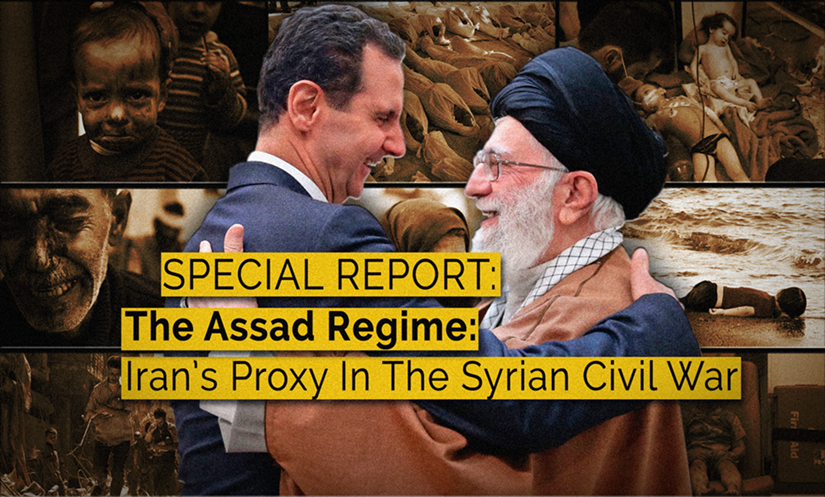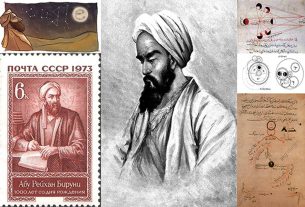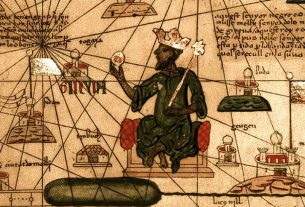Fri 17 May 2019:
The Iranian-Syrian alliance stretches back over three decades, constituting one of the most enduring alliances among authoritarian regimes in the region. When the relationship began in the early 1980s, Damascus had the upper hand and then-Syrian president Hafez al-Assad was keen to maintain a formal distance with the Islamic Republic and its Lebanon-based proxy, Hezbollah. The situation changed with the ascent of Bashar al-Assad – hailed as a “reformer” – to the presidency, who established a warmer relationship with Tehran and Hezbollah on a more equal footing.
Iran views the maintenance of Assad’s control in Syria as a check against Sunni power in Syria and the greater Middle East. Through the Assad regime, Iran is further able to project its influence throughout the Levant. In a testament to Assad’s utility, the Islamic Republic and its proxies have played the critical role in saving and sustaining Bashar al-Assad’s regime amidst the ongoing Syrian Civil War, which began in March 2011. Because Assad has been so instrumental in serving Iranian interests, Tehran views his downfall as an existential threat, referring to Syria as its strategically important “35th province.”
Iran has been a full participant in Assad’s brutal war to suppress the Syrian uprising, conducting an extensive, expensive, and integrated effort to keep President Bashar al-Assad in power. Iran is effectively in charge of planning and leading the conduct of the conflict and has provided the Assad regime with a nearly $6 billion line of credit, underscoring its increased reliance on Iran. Iran has now positioned itself Damascus’ closest ally, declaring it will support Assad to the end.
Meanwhile, Iran and its proxies are setting conditions to retain their ability to use Syrian territory and assets to pursue their regional interests after the war ends and Assad regains control over the country. As early as August 2012, IRGC General Salar Abnoush declared, “Today [Iran is] involved in fighting every aspect of a war, a military one in Syria and a cultural one as well.” Now, Iran and its proxies command the Assad regime’s war against rebel forces, directing important battles and even giving orders to the Syrian Arab Army, which has taken on a secondary role.
In the early stages of the conflict, Iran offered limited assistance to the Assad regime in the form of technical and financial support, facilitated primarily through the IRGC Quds Force. Beginning in 2012, Iran’s military and economic support to the Assad regime increased markedly to prevent the collapse of Assad’s rule. This steadfast support continued with Hassan Rouhani’s inauguration as Iranian President in 2013.
Speaking with then-Syrian Prime Minister Wael al-Halqi in August 2013, Rouhani vowed, “the Islamic Republic of Iran aims to strengthen its relations with Syria and will stand by it in facing all challenges. The deep, strategic and historic relations between the people of Syria and Iran… will not be shaken by any force in the world.” Iran has kept its word, deepening its involvement in Syria over the subsequent years, and deploying not only thousands of its regional proxies into the country, but also the IRGC and Iran’s regular army (Artesh). That support was critical in stabilizing Assad’s rule until Russia’s entry into the Syrian Civil War in 2015, and the regime’s 2016 victory in Aleppo, which has perhaps decisively swung the war’s momentum in Assad’s favor.
Military Support
The Iranian regime’s support for Syria is broad and comprehensive, and includes deploying Iranian troops inside Syria, technical assistance, and training for Syrian forces. As early as December 2013, Islamic Revolutionary Guard Corps (IRGC) Maj.-Gen. Mohammad Ali Jaafariboasted, “[Iran has] special forces transferring experience and training who are doing advisory work.” Initially, Iranian support was limited to advising and training Assad regime forces. However, subsequently, Tehran has greatly expanded its support to include deployingthousands of IRGC, Artesh and Basij fighters to take direct part in the Syrian Civil War’s battles.
Arms Shipments and Other Military Equipment

Most of Iran’s arms shipments to Syria are supplied via air transport. One Syrian official has said the IRGC conducts “regular clandestine flights between Tehran and Damascus,” up to three times a week, and “none of them appearing on public timetables.”
Since the beginning of the Syria conflict, the U.S. has sanctioned three Iranian airlines — Yas Air, Iran Air, and Mahan Air — for transporting military equipment and personnel from Iran to Syria. On multiple occasions, Turkish authorities have intercepted Iranian weapons cargo bound for Syria. In the first month of the Syrian uprising in March 2011, Turkish authorities seized 19 crates containing assault rifles, machine guns, ammunition, and mortar shells from an Iranian Yas Air cargo aircraft that had listed its goods as “auto spare parts.”
These Iranian flights pass primarily through Iraqi airspace into Syria and, in 2014, then-Iraqi Foreign Minister Hoshyar Zebari has said his country lacks the ability to stop them. Analysts disagreed, saying Iraq could insist on cargo planes that depart from Iran to Syria land for inspection in Baghdad, or “declare outright that Iraq’s airspace cannot be used for the flights. However, Iraq’s dependency on Shiite militias ideologically loyal to Iran in the fight against the Islamic State may complicate Baghdad’s ability to confront Tehran on the matter.
Intelligence Support
In tandem with military support, Iran has provided the Assad regime with intelligence technology and training. In a June 2011 sanctions action, the U.S. Department of Treasury stated Iran’s Law Enforcement Forces (LEF) – which committed human rights abuses against Iranian protesters in 2009 – provided assistance to the Syrian General Intelligence Directorate and dispatched personnel to Damascus to aid in suppressing Syrian dissidents. In addition to the LEF, the IRGC Intelligence Organization, Iranian Ministry of Intelligence and Security (MOIS), and Iran Electronics Industries (IEI), have also provided the Syrian government with intelligence training and technical support.
Economic Support

Staffan de Mistura, the U.N. Special Envoy for Syria, has stated that Iran has been spending somewhere between $6 million to $35 million annually to support Assad’s regime in Syria. One U.S. military official put this number at $15 billion in the first half of 2017 alone.
Tehran has also greatly expanded its economic ties with Damascus during the Civil War, implementing a Free Trade Agreement in 2012 to boost bilateral trade to $2 billion from around $700 million, and is using its own oil tankers to transport Syria’s embargoed crude oil, disguise its origins, and get it to market.
Iran stepped up its provision of diesel fuel to the Syrian regime during the Civil War, fueling the Syrian Army’s heavy ground vehicles – including tanks, infantry fighting vehicles, and heavy transport. Tehran has done so through direct shipments as well as by providing Assad with credit lines to purchase the fuel. Additionally, Iran has provided Syria diesel in exchange for gasoline, a boon of hundreds of millions of dollars to the cash-strapped Syrian government.
Chemical Weapons
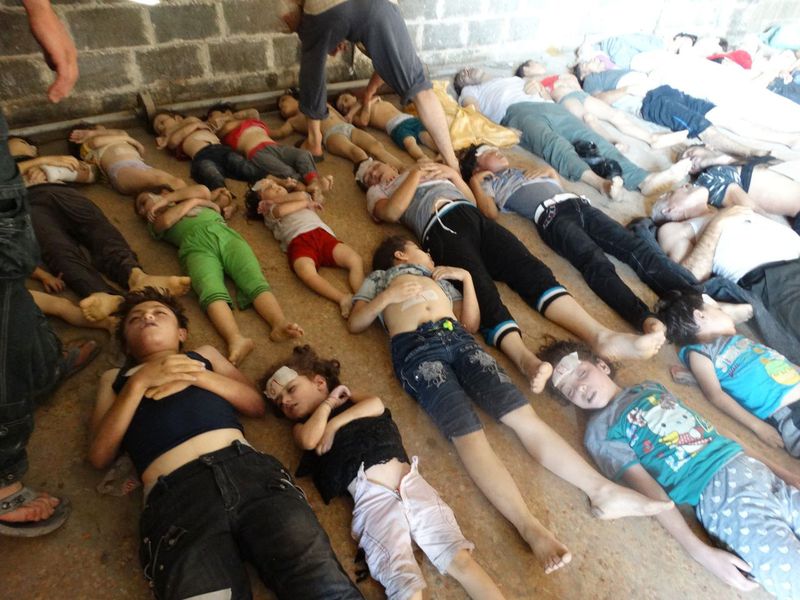
Iran helped develop Syria’s chemical weapons program and its stockpile, which have been used to indiscriminately massacre civilians. U.S. diplomatic cables revealed that Iran provided Damascus the construction design and equipment to produce “tens to hundreds of tons” of VX, Sarin and mustard gas as early as 2005-2006. Tehran was also the source of Damascus’ Chinese-manufactured chlorine gas bombs, routinely dropped by Syrian Army helicopters on civilian areas. Iran may have also provided Syria with the delivery platforms for these CW weapons, including a 330mm surface-to-surface rocket believed to be based on Iran’s 333mm Falaq-2 launcher.
On August 21, 2013, the Syrian government launched a chemical weapons attack on the opposition-controlled Damascus suburbs of Eastern and Western Ghouta, which left hundreds of innocent civilians dead, including many women and children. Beyond providing chemical weapons, Iranian officials and the propaganda apparatus rushed to cast doubt on the veracity of the chemical attack in Ghouta, claiming rebels were the responsible party. The same pattern repeated itself in April 2017 after the Syrian government used Sarin gas on the town of Khan Sheikhoun, killing 89 civilians, including 10 children.
Provision of Military Personnel and Proxies
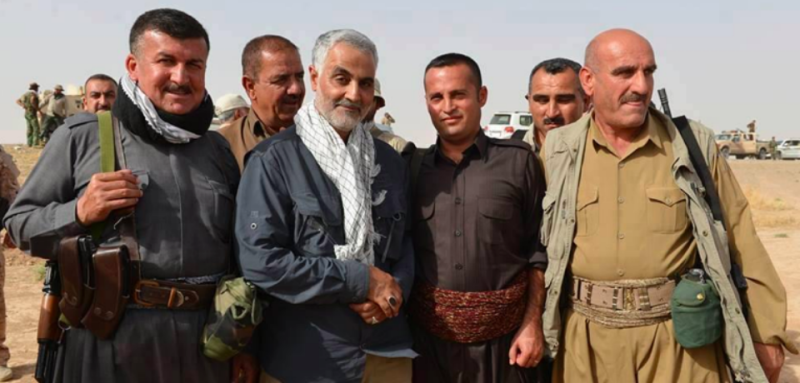
Iranian Forces
U.S. defense officials say Iranian assistance rose sharply during the summer of 2012, as Assad risked losing power due to rebel advances and force attrition. Iran began sending hundreds of IRGC and Basij fighters to Damascus, stanching and eventually reversing Assad’s losses. Today, IRGC, Artesh, and Shiite militia proxies comprise the bulk of the forces fighting to restore the Assad regime’s control over Syria. IRGC Quds Force commander Qassem Soleimani is at the head of these forces, coordinating activities among the various Shia mercenary forces and ensuring that their activities fulfill Iranian foreign policy objectives. As the Assad regime has weakened, it has become increasingly reliant on the local and foreign Shia militias beholden to Iran to seize and hold territory.
Soleimani has a long history of expanding Iran’s regional influence through violent means, including directing Iraqi Shiite militant groups attacking U.S. forces in Iraq. Both Free Syrian Army and U.S. defense officials agree, Soleimani is now running the war, and Bashar al-Assad is his de facto deputy. Assisting Suleimani are a number of notorious senior IRGC officers, including Generals Hossein Hamadani and Yadollah Javani, both of whom oversaw Tehran’s 2009 crackdown on Iranian democracy protesters.
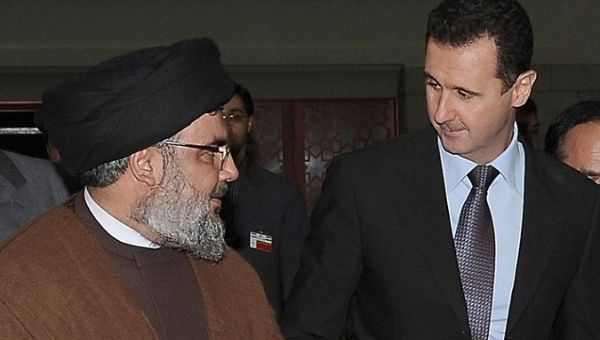
Hezbollah
Under Iranian direction, Hezbollah entered the Syrian Civil War on Assad’s side in 2011 and has been critical to his regime’s survival. The group openly admitted its involvement in the war in 2013, when it was fighting for the strategic Syrian town of Qusayr. Since then, Hezbollah has deployed approximately 5,000-8,000 fighters into the Syrian arena, and over 1,600 of them have been killed. The group has been involved in almost every major battle of the war, including the repeated offensives in Qalamoun and Zabadani, but most critically the battle of Aleppo. The battle of Aleppo ended with a regime victory in December 2016, perhaps irreversibly turning the tide of the Syrian war.
After averting the direct rebel threat to Damascus, Hezbollah is acting to re-extend the regime’s control over all of Syria. In May of 2017, Hezbollah’s Secretary General Hassan Nasrallah announced the withdrawal of his forces from positions on the Lebanese-Syrian border. Rather than demobilizing, however, they were sent deeper into eastern Syria as part of a large-scale operation to retake the country’s borders with Jordan and Iraq and to join with Popular Mobilization Forces charging from the Iraqi side of the border.
Hezbollah has made clear it intends to remain in Syria, and is laying permanent groundwork for the day after an eventual Assad victory. Hezbollah has reportedly established missile bases in Qusayr and Qalamoun to better protect its longer-ranger projectiles from Israeli aerial attacks. It has also engaged in large-scale sectarian cleansing of Sunnis from the area to secure its Beqaa Valley and Baalbek strongholds across the border and guarantee its land corridor to Damascus. Critically, an Iranian-Qatari brokered population swap deal in April 2017 transferred almost all remaining Sunni combatants from the area, in exchange for the Shiite residents of besieged Foua and Kefraya. Rumors are now circulating that the group is planning a large-scale operation by the end of summer 2017 to root out the remnants of rebel forces on the Lebanese-Syrian border.
The group is also aiming to establish a presence on the Syrian side of the Golan Heights, a matter of concern for the Israelis. This would not threaten Israel’s military superiority in the area, since the Israelis occupy the high-ground and the flat terrain between the Golan and Damascus can easily be seized by IDF ground troops. However, it could serve as a base for Hezbollah to carry out limited strikes against soldiers or civilians in Israeli-held territory in a future conflict.
Israeli security officials say Hezbollah is also exploiting the chaos of Syria’s civil war to clandestinely import advanced, balance-altering weapons – allegedly including chemical weapons, SCUDs , and Yakhont anti-ship missiles – from its Iranian patron and the Assad regime. These weapons would be a major upgrade from the short-range and unguided katyusha rockets that have been the group’s traditional mainstay, and which make up the bulk of its oft-mentioned arsenal of 150,000 rockets. Israel considers this a red line and has repeatedly intercepted and destroyed these weapons with air strikes.
Local Actors
Iran’s Qassem Soleimani and Hezbollah personally oversaw the creation of the National Defense Forces (NDF), a pro-government militia formed in 2012 and operating as a part-time volunteer reserves of the Syrian Army. The NDF is now by far the largest militia network in Syria, created through the merging of local Popular Committees and other pro-Assad armed groups.
NDF recruits local volunteers willing to fight against rebel factions. They receive training in urban and guerilla warfare from both the IRGC and Hezbollah at facilities in Syria, Lebanon and Iran. The IRGC and Hezbollah have organized the recruits along the model of Iran’s Basij militia. Estimated at approximately 50,000 primarily Alawite members as of late 2015, the NDF acts as an infantry force, coordinating its operations with the Syrian Army.
The NDF has participated in critical battles, including the 2016 Aleppo offensive and the current campaign to dislodge ISIS from Deir Ezzor.
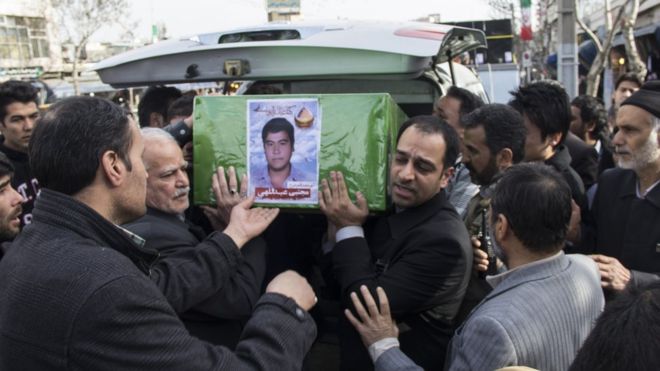
Shiite Militia Proxies
In addition to Hezbollah, Iran has mobilized, funded, and armed thousands of Shiite fighters to defend Assad’s regime, inflaming Sunni-Shiite sectarian tensions in the process. These fighters have been recruited from across the Arab and Islamic world, including Iraq, Afghanistan and Pakistan. In late 2016, Israeli officials estimated that Iran commanded approximately 25,000 fighters in Syria. Iran’s efforts to recruit Shia militants to the Syrian war effort from around the Middle East and beyond center upon the salaries it offers its disaffected conscripts. Recruits are offered monthly salaries on a sliding scale dependent on country of origin, basic and advanced military training, and Iran offers to pay the families of “martyrs” for their children’s education and to send family members on annual pilgrimages to holy sites in Iran, Iraq, and Syria.
Conclusion
Iran’s assistance has been critical in keeping Assad in power, even as the international community has sought to put an end to his atrocities against the Syrian people. It was also instrumental in transforming the Syrian Civil War into a regional sectarian battle between Sunni and Shiite extremists, rather than a local uprising against a brutal dictator. The assistance from Iran and its proxies has kept Assad in power long enough for Russian intervention to turn the tide of the battle in his favor. Particularly after the victories Iran and its proxies gave Assad in Aleppo and the success of the campaign into Badiyat al-Sham, the Syrian dictator will be less inclined to provide concessions to opposition forces.
Moreover, what began as an Iranian-sponsored attempt to create a “Useful Syria” from the regime’s major cities and economic centers has now become a more ambitious campaign to retake the entire country. With the Assad regime and allied forces – including Hezbollah and other Iranian proxy militias – retaking areas on the Iraqi-Syrian border north of al-Tanf and Abu Kamal, and Iranian-sponsored members of the Popular Mobilization Units reaching the Syrian border from the Iraqi side, the Islamic Republic is closer to creating a land-bridge that would link its own territory to Hezbollah’s Beqaa valley stronghold via Iraq and Syria.
Iran’s Syrian intervention has paid off, as Assad’s survival seems assured while his weakened position both domestically and within the international community all but guarantees he will remain a subservient Iranian client. For its efforts to shore up Assad, Iran and the IRGC – which has a hand in virtually every sector of the Iranian economy – are positioned to further carve out a long-term role for themselves in Syria, utilizing the cover of military and economic projects to export the Islamic Revolution by creating Shi’a militias and quasi-state institutions loyal to Iran and its Supreme Leader within Syria.
Both the NDF and Lebanese Hezbollah appear to be permanent fixtures in Syria as well, remaking a country that historically “was home to many competing ideological forms of Shiism” in Iran’s image. Hezbollah and the NDF’s secure Iranian alignment and loyalty to its revolutionary ethos gives Iran a foothold to project its ideological influence into Syria for years to come. As Iran further entrenches its control over Syria, it will increasingly seek to marshal its proxies to project power throughout the Levant, increasing the likelihood of eventual future conflict with Israel.
Think your friends would be interested? Share this story!


